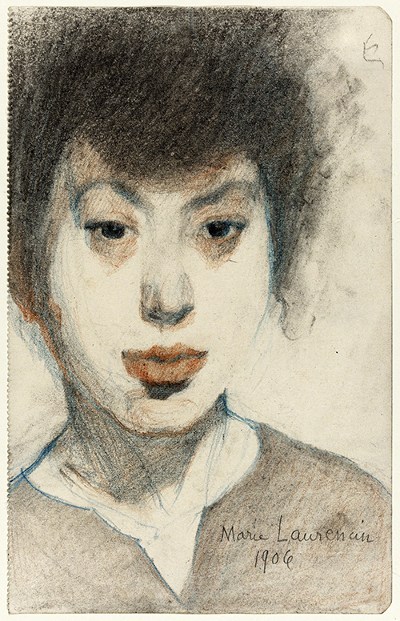Pride Month 2024: Marie Laurencin
It’s the beginning of LGBTQ+ Pride Month, which was initially celebrated as a single day in late June. Over time, it evolved into a month-long celebration of the Stonewall Uprising that occurred in June 1969 in New York. That historic event unofficially marked the beginning of the Gay Rights Movement. In celebration of Pride Month, I present the work of painter, printmaker, and stage and costume designer, Marie Laurencin. With her bold personality, Laurencin stood toe-to-toe with early modernist artists in Paris, who labeled her art “too feminine” because of the predominance of female figures. She was also known for her multiple-gender attraction. Despite the danger of being openly bisexual in Paris during World War II (1939–1945) and the Nazi occupation, Laurencin remained in Paris and successfully resurrected her theater and ballet designs after the war.
 |
| Marie Laurencin (1883–1956, France), Self-Portrait, 1906. Colored pencil and pencil on notebook paper, 7 ¾" x 4 15⁄16" (19.8 x 12.5 cm). Courtesy of the Museum of Modern Art, New York. © 2024 Artists Rights Society (ARS), New York. (MOMA-P0873luars) |
This self-portrait dates to a couple years after Laurencin’s time at the Academy Humbert in Paris. It reveals a more incisive drawing skill and grasp of monumental form than came out in her subsequent mature painting style. If anything, it reflects the dissolution of form of Impressionism with the gestural immediacy of Expressionism. While the portrait is by no means a window into Laurencin's personality, it certainly shows that she was not a fan of idealizing her own particularly striking features, including her prominent lips and bags under her eyes.
The period when Laurencin patronized the most progressive artist groups in Paris was around the time that Georges Braque (1882–1963) and Pablo Picasso (1881–1973) developed Cubism from 1908 to 1914. Cubism was instrumental in the revolutionary redefinition traditional pictorial space and form in art, injecting painting with the elements of time and multiple vantage points in a single artwork. The shattering of form into faceted planes and cubes helped pave the road to total nonobjective abstraction.
Laurencin’s simple, almost naïve, style of painting is more reminiscent of Henri Rousseau (1844–1910) than Cubist artists. However, she actually exhibited her works with Cubists in the annual Salon des Indépendants in 1910 to 1911. Although immersed in the conversations about Cubism and its resultant offshoots, Laurencin’s personal style took a unique path, through which she ultimately explored theater design and book illustration.
Born and raised in Paris, Laurencin went to Sèvres outside of Paris in 1901 to study ceramic design at the famous national porcelain factory there. Dissatisfied with ceramic design, she returned to Paris and studied at the Academy Humbert, a cheap alternative to the School of Fine Arts, from 1903 to 1904. While there, she met Cubism innovators Picasso, Braque, and Francis Picabia (1879–1953). Although involved in their discussions on redefining art theory, it had little effect on her personal style.
Characterized by pastel colors and airy atmospheres, Laurencin’s mature style usually involved young, melancholy female figures. She was ultimately influenced by the feminine, pastel tendencies of French Rococo art and the elegant line and simplicity of Iranian miniature painting from the Safavid period (1502–1736). Laurencin also painted children and still life. The 1920s was the most productive period for Laurencin, when she emphasized painting portraits of wealthy people. In the 1930s, she experimented with landscapes and was commissioned to design sets and costumes for several ballet companies.
Correlations to Davis programs: Explorations in Art 2E Grade 1: 2.1, 2.2; Explorations in Art 2E Grade 2: 2.3; Explorations in Art 2E Grade 3: 1.1; Explorations in Art 2E Grade 6: 1.6, 1.9; Experience Art: 1.1; A Global Pursuit 2E: 2.3; A Personal Journey 2E: 3.2, 6.4; Experience Printmaking: p. 64; Exploring Painting: pp. 104–105


Comments